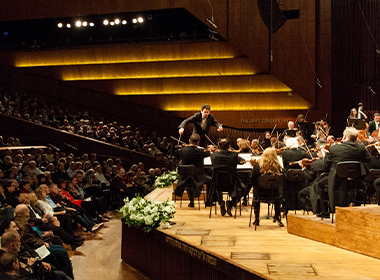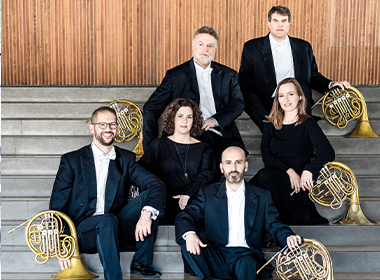The name Alan Gilbert (born 1967) became recognizable almost overnight after he was appointed Music Director of the New York Philharmonic Orchestra in 2009, an appointment that was not the obvious one. He was the first New York native to be appointed to this position. Born in New York, he lived near Lincoln Center and spent countless hours there—and not only because his two parents were violinists in the orchestra. Gilbert brought a new spirit to the orchestra by programming and commissioning contemporary works, creating new Artist-in-Residence and Composer-in-Residence roles for the orchestra, emphasizing educational and community work, and understanding that this orchestra should renew and influence musical life in New York, the United States, and around the world. When Gilbert finished his term as Music Director in 2017, there was no doubt he had significantly changed the face of the New York Philharmonic.
The program he brings to his concert series with the Israeli Philharmonic Orchestra demonstrates how Gilbert combines well-known works (such as those by Weber, Rachmaninoff, and Dvořák) with lesser-known works (as in Nielsen‘s Third Symphony) and new works (such as Exquisite Corpse by Swedish composer Anders Hillborg).
The Israeli pianist Inon Barnatan is already a regular guest in the most important venues around the world. He has performed as a soloist with the Cleveland Orchestra, Los Angeles Philharmonic Orchestra, Chicago Symphony Orchestra, Gewandhaus in Leipzig, and the Philharmonic orchestras in London and Helsinki. Born in Tel Aviv in 1979, he first studied with Victor Derevianko and continued his studies at the Royal Academy in London. Like Alan Gilbert, Barnatan is also considered a musician with his feet firmly planted in both the contemporary and classical worlds. Gramophone called him “a born Schubertian,” but he also performs a great deal of contemporary music by composers such as Sebastian Currier, Avner Dorman, and Matthias Pintscher.
It turns out that 1979 produced an impressive crop of soloists. Lisa (Elisabeth) Batiashvili was born (like Barnatan) in 1979 in Tbilisi, Georgia. At the age of 11 she moved with her family to Germany and continued her studies at the Hochschule für Musik und Theater in Hamburg. She is considered one of the most fascinating soloists of our time, and was artist-in-residence at the New York Philharmonic Orchestra between the years 2014-2015 (during Alan Gilbert‘s time as a musical director). Alongside the classical repertoire, she commissioned and played concert performances by composers such as Magnus Lindberg and Giya Kancheli.
The conductor and composer Leonard Bernstein had a special sense for great works by composers who were not necessarily widely recognized. Let us not forget that it was Bernstein who brought to the public consciousness the symphonies of Mahler, Shostakovich, Prokofiev, and Ives. In 1962, Bernstein ”discovered” a “new” composer—at least to the wider world—the important Danish composer Karl Nielsen. The recording of Nielsen‘s Fifth Symphony by the New York Philharmonic Orchestra for CBS Records led many music fans to ask, ”how have we not heard of this composer before?” When Bernstein recorded the Third Symphony of Nielsen (in 1965), the world already understood that before us were both an important composer and a wonderful piece. Today there seems to be no dispute about the importance, quality, and musical value of Nielsen‘s works.
Nielson’s Third Symphony, written between 1910-11 (in 1911 Sibelius conducted the premiere of his Fourth Symphony in Helsinki, and Roald Amundsen conquered the South Pole). The subtitle, “Sinfonia Espansiva” was given to the work by the composer himself. Why was this name given to the symphony? It does not require large performance forces, it is not very long (the four movements together are around 36 minutes), and except for the use of soprano and baritone vocalizations in the second movement, it is not a work of large proportions. Among Nielsen’s researchers was the composer Robert Simpson, who suggested the accepted view of the work that this is an “expansion of knowledge” in musical thought and insights that transcend the limits of the composer’s thinking and fertilize the whole world (perhaps one needs to be a Dane to be optimistic in this way). And apparently, if one is seeking a bit of an optimistic perspective, an expansion of the 19th century musical language without an obsessive search for innovations, then Nielsen‘s Third Symphony could be the right work. It is clear and accessible, somewhat reminiscent of Shostakovich‘s early symphonies, but without the irony or bitterness of the Soviet composer. Biographical anecdotes indicate that this symphony may also symbolize the composer‘s release from the distress caused by his marriage, but music will recall music and for one reason or another the world has gained a charming and graceful work. Alan Gilbert, Bernstein‘s successor in many ways, performs this work often around the world. This will be one of the first encounters the Israeli audience has with this piece.
Bernstein rediscovered the music of Carl Nielsen, and the ”Exquisite Corpse” by Anders Hillborg (born 1954)—an important Swedish composer of today—was dedicated to Alan Gilbert, who gave the premiere performance in 2002. The composer describes the work as ”accessible and representative of my compositional world.” The intriguing name came out of a social game that was common in the 1920s, where one of the participants had to create a sentence (each participant gave a word during his turn) without any of them knowing what the other wrote. In one of the cases, the sentence created was ”the exquisite corpse drank the young wine”… Hillborg writes that for the surrealists of the early 20th century such a game could reveal ”streams of consciousness” and flood the possible beauty of chance and ”irrational connections.” For him, there is an opportunity to ”invite to the game” composers such as Ligeti, Sibelius, and Stravinsky. The success of Hillborg and the fact that he has been composing concert, electronic, choral and music for film and television has long intrigued him to know his work.
It seems everything has already been written about Rachmaninoff‘s piano concertos. And if there was a music lover who was not exposed to them before piano competitions became an important component of the culture of classical music consumption, in recent years it seems that not a year goes by when dozens of performances are not added to these works. Perhaps the reason for this is that the pianist‘s writing is that of a star pianist as well as an excellent composer: his music is idiomatic and precise, the solo textures fit the performer’s ten fingers ”like a glove,” and the emotional range of the work is all that a performer can ask. ”This is a great gift to the history of piano literature from an excellent pianist who is also a great composer” said Arthur Rubinstein at the time. One of the less obvious aspects of Rachmaninoff‘s biography was his tendency towards profound sadness (or grief, or even depression, depending on the period and perspective). In this light we can understand the dedication of the work to Nikolai Dahl, who was a physician and hypnotist who restored the composer’s faith and self-confidence after his first concerto and symphony failed miserably in their debut performances. It seems Dahl did an excellent job because the second piano concerto marked the beginning of the indisputable success of Rachmaninoff‘s 28-year-long career. Biographers also note that shortly after the success of the concerto, Rachmaninoff married the love of his life, Natalya Satina.
Perhaps the most interesting story about Prokofiev‘s Second Concerto for Violin relates to what immediately followed its premiere (in Madrid on December 1, 1935). Prokofiev made the decision to return to the Soviet Union, after a self-imposed exile that began immediately after the First World War. This fact seems to be of musical importance, as one notices in this concerto the relatively simple writing, but with an extremely emotional and expressive attitude. Did Prokofiev consciously or unconsciously end his affair with the European avant-garde? Was there an aesthetic declaration of intent that preceded his concrete decision to return to his homeland? Prokofiev was often perceived as an ironic, biting, and sarcastic composer (for which he was praised by American and European musicians). He succeeded in harnessing the appeal of classic tonalities in service of garnering appeal for his ”biting” expressions, and with this concerto, he presents a different aspect of his personality. A closer examination of his biography shows that he had an interest in reaching broad audiences and not limiting himself to the circles of the musical elite, as evidenced by an article he wrote in 1934, ”In Praise of Melody.” Here, Prokofiev raised the idea that simplicity is an important musical value, but he urged composers to think of simplicity not as a nostalgic matter or an imitation of the past, but to create a ”new, fresh simplicity.” The second violin concerto seems to be an excellent example of the application if these ideas. This concerto, seemingly less complex than the first concerto, is nonetheless special and original. The expressive opening of the solo instruments, the fresh and captivating melodic line in the second movement, and the ”sarcastic” harmonies in the third movement, which gives an impressive role to the percussion instruments, leave no room for doubt as to the originality and uniqueness of the composer.
Weber composed the opera “Oberon” in 1826 for London’s Covent Garden Opera House. The plot resembles “A Midsummer Night’s Dream,” but the work is based on a poem by German poet Christoph Martin Wieland. From the first notes of the overture, Weber beautifully evokes the elves and fairies that abound in the forest. The London audience was thrilled with the work and demanded the orchestra return on stage to play the overture again. Veterans of the Palestine Symphony Orchestra (now the IPO) remember well the blast of Horst Salomon’s horn in the overture.
Five really unimportant things to know about Dvořák (prior to the performance of his Ninth Symphony):
- His height was 1.78
- He lived 62 years 7 months and 23 days
- To listen to all his compositions in sequence requires three and a half days (about 85 hours)
- He conduced 112 concerts
- In 1901 he was appointed member of the Austrian parliament.
And four things that one should know about Dvořák in preparation for the Ninth Symphony, ”From the New World”:
Dvořák arrived in New York at the invitation of New York socialite Jeanette Thurber, who asked the well-known composer to run the National Conservatory. Dvořák‘s condition was that talented black and Native American students who could not pay the tuition would be taught free of charge. His relations with these minority populations were also fruitful in terms of the influence of their music on his works, and this is evident in various works written by him at the time, including the Ninth Symphony.
About a year after his arrival in the United States, a large orchestral work was commissioned from him for the New York Philharmonic Orchestra, thus his ninth and final symphony was born.
Dvořák claimed that he did not quote melodies from American music, but composed his own melodies in the same style.
Dvořák ‘s Symphony No. 9 has become one of the most successful works in the world and is often performed in concert halls. Especially famous is the second movement, Largo, which has become a favorite and popular tune among classical music lovers.
program no.1
Alan Gilbert, conductor
Inon Barnatan, pianist
Anastasia Klevan, soprano
Oded Reich, baritone
Anders Hillborg: Exquisite Corpse
Rachmaninov: Piano Concerto no. 2
Nielsen: Symphony no. 3 (“Sinfonia espansiva”)
program no.2
Alan Gilbert, conductor
Inon Barnatan, pianist
Weber: Oberton Overture
Rachmaninov: Piano Concerto no. 2
Dvorak: Symphony no. 9 (“New World”)
program no.3
Alan Gilbert, conductor
Lisa Batiashvili, violinist
Anastasia Klevan, soprano
Oded Reich, baritone
Weber: Oberon Overture
Prokofiev: Violin Concerto no. 2
Nielsen: Symphony no. 3 (“Sinfonia espansiva”)








 Back to top
Back to top




